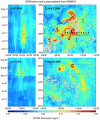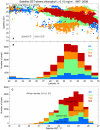Summer diatom blooms in the North Pacific subtropical gyre: 2008-2009
- PMID: 22493663
- PMCID: PMC3320889
- DOI: 10.1371/journal.pone.0033109
Summer diatom blooms in the North Pacific subtropical gyre: 2008-2009
Abstract
The summertime North Pacific subtropical gyre has widespread phytoplankton blooms between Hawaii and the subtropical front (∼30°N) that appear as chlorophyll (chl) increases in satellite ocean color data. Nitrogen-fixing diatom symbioses (diatom-diazotroph associations: DDAs) often increase 10(2)-10(3) fold in these blooms and contribute to elevated export flux. In 2008 and 2009, two cruises targeted satellite chlorophyll blooms to examine DDA species abundance, chlorophyll concentration, biogenic silica concentration, and hydrography. Generalized observations that DDA blooms occur when the mixed layer depth is < 70 m are supported, but there is no consistent relationship between mixed layer depth, bloom intensity, or composition; regional blooms between 22-34°N occur within a broader temperature range (21-26°C) than previously reported. In both years, the Hemiaulus-Richelia and Rhizosolenia-Richelia DDAs increased 10(2)-10(3) over background concentrations within satellite-defined bloom features. The two years share a common trend of Hemiaulus dominance of the DDAs and substantial increases in the >10 µm chl a fraction (∼40-90+% of total chl a). Integrated diatom abundance varied 10-fold over <10 km. Biogenic silica concentration tracked diatom abundance, was dominated by the >10 µm size fraction, and increased up to 5-fold in the blooms. The two years differed in the magnitude of the surface chl a increase (2009>2008), the abundance of pennate diatoms within the bloom (2009>2008), and the substantially greater mixed layer depth in 2009. Only the 2009 bloom had sufficient chl a in the >10 µm fraction to produce the observed ocean color chl increase. Blooms had high spatial variability; ocean color images likely average over numerous small events over time and space scales that exceed the individual event scale. Summertime DDA export flux noted at the Hawaii time-series Sta. ALOHA is probably a generalized feature of the eastern N. Pacific north to the subtropical front.
Conflict of interest statement
Figures









References
-
- Wilson C. Late Summer chlorophyll blooms in the oligotrophic North Pacific Subtropical Gyre. Geophysical Research Letters. 2003;30:1942. doi: 1910.1029/2003GL017770.
-
- Villareal TA, Adornato L, Wilson C, Shoenbachler CA. Summer blooms of diatom-diazotroph assemblages (DDAs) and surface chlorophyll in the N. Pacific gyre – a disconnect. Journal of Geophysical Research-Oceans. 2011;116 doi: 10.1029/2010JC006268. - DOI
-
- Wilson C, Villareal TA, Maximenko N, Montoya JP, Bograd SJ, et al. Biological and physical forcings of late summer chlorophyll blooms at 30° N in the oligotrophic Pacific. Journal of Marine Systems. 2008;69:164–176.
-
- Wilson C, Qiu X. Global distribution of summer chlorophyll blooms in the oligotrophic gyres. Progress in Oceanography. 2008;78:107–134.
-
- Dore JE, Letelier RM, Church MJ, Lukas R, Karl DM. Summer phytoplankton blooms in the oligotrophic North Pacific Subtropical Gyre: Historical perspective and recent observations. Progress in Oceanography. 2008;76:2–38.
Publication types
MeSH terms
Substances
LinkOut - more resources
Full Text Sources

